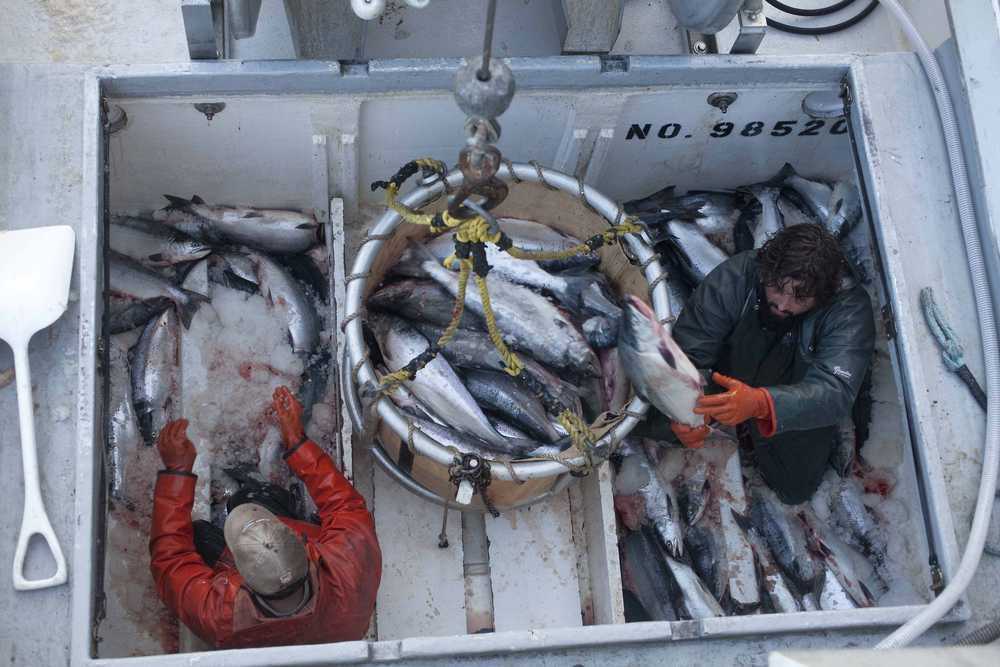Commercial fisheries managers in the Cook Inlet are predicting a run of about 5.8 million sockeye salmon with a harvest of about 3.7 million of those fish by all user groups, according to its 2015 outlook for commercial salmon fishing.
Commercial Area Management Biologist Pat Shields said the harvest, if the forecast is correct, would be about average.
The Kenai River sockeye salmon forecast is about 3.6 million fish, while the Kasilof River sockeye salmon run is about 1,092,000. On the Susitna River, 276,000 sockeye salmon area expected to return.
The Kasilof River salmon run is slightly higher than its 20-year average, while the Susitna River sockeye salmon forecast is lower, according to the outlook.
Given that outlook, and the outlook for Kenai River king salmon which, while higher than last year’s forecast is still lower than average, Shields said commercial fishermen should expect to fish similarly to the 2014 season.
The 2015 season will be the second that commercial drift and set gillnet fisheries operate under the new management actions put forward during the 2014 Upper Cook Inlet Board of Fisheries meeting.
The Kenai River late run king salmon forecast projects a total run of about 22,000 fish.
In the set gillnet fishery on the east side of the Cook Inlet before July 1, the Kasilof Section can open as early as June 20, depending on how many sockeye salmon have been counted in the Kasilof River. That portion of the set gillnet fishery spans the beach from Ninilchik to a point about halfway between the Kenai and Kasilof Rivers known as the Blanchard Line.
The Kenai and East Forelands section of the east side setnet fishery typically opens on or after July 8, depending on the struggling Kenai River king salmon run.
If late run Kenai River king salmon are projected to be at fewer that 22,500 fish, the entire setnet fishery will be held to no more than 36 hours per week of fishing and regular fishing periods will be suspended.
In 2014, managers were held to that 36 hour per week rule and ended up using an area at the mouth of the Kasilof River extensively to control sockeye escapement into that river.
Sockeye flooded the Kasilof River early in 2014 and managers put the Kasilof Section of the set gillnet fishery into the water on June 23 in what became a pattern of fishing the commercial set and drift gillnet fleets to keep from going over the top of the river’s escapement goal.
While the entire east side setnet fishery was put into the water for just five total fishing periods last year, the area at the mouth of the Kasilof River known as the Kasilof Special Harvest Area was fished extensively by setnetters.
“Last year (the Kasilof River sockeye run) was a strong run, not the strongest we’ve ever seen but it was strong early and we got behind,” Shields said. “We were halfway through the season and we’d already met or nearly exceeded our escapement goal in the Kasilof for sockeye salmon.”
Shields said the special harvest area could again be extensively fished, depending on the strength of the Kasilof-bound sockeye salmon run.
Fishermen have expressed concern about the number of king salmon taken by setnetters in that area, Shields said.
Last year, setnetters in that area took about 625 king salmon according to Fish and Game data. Genetic sampling of that catch in 2013 showed that between 70-75 percent of those king salmon were headed for the Kasilof River, while the vast majority of the remaining king salmon were bound for the Kenai River.
In that same time period, setnetters took nearly 200,000 sockeye salmon.
“So that’s about 470 of those king salmon last year that might have been Kasilof king salmon,” Shields said. “Those are the types of decisions we’re faced with here. So when you look at that data you go, 470 king salmon for 200,000 sockeye salmon … that’s probably a pretty fair trade.”
Still, despite the low percentage of Kenai-bound king salmon caught in that fishery, Shields said his department was careful to consider the Kasilof River king salmon run as well when fishing setnetters in the special harvest area.
“It’s not a perfect tool and everybody recognizes that,” he said. “We use it realizing that we’re catching king salmon runs in there and if king salmon are weak in the Kenai River, it’s possible they could be weak in the Kasilof River. We just don’t measure them there.”
Central district drift gillnetters typically open by the third week of June and have several time and area restrictions in the inlet depending on the size of the Kenai River sockeye salmon run.
Fish and Game is projecting a run of about 3.6 million sockeye salmon which means that drifters could get an additional 12-hour period before July 15 — though they’re restricted to a section of the Cook Inlet near the Kenai River, one near the Kasilof River and Drift Area 1 which spans nearly the entire width of the Cook Inlet from Anchor Point to a line south of Kalgin Island, according to that fishery’s management plan. After July 16, the drift fleet is restricted to one 12-hour period that can include the larger Drift Area 1; all other fishing time must happen in only the Kenai, Kasilof and Anchor Point sections which run closer to the shore on the east side of the inlet.
For four years, the Northern District king salmon set gillnet fishery has been restricted by time and area to reduce its harvest of norther Cook Inlet king salmon.
Escapements have improved moderately, according to Fish and Game data, however seven king salmon stocks in the northern district are listed as stocks of concern.
Fish and Game’s fishing strategy will mimic the 2014 season by closing the first period of the season — scheduled for May 25 — and closing an area of the beach from a point at the wood chip dock north to the Susitna River for the entirety of the season, according to the 2015 outlook for commercial salmon fishing.
Managers also cut the time in half for the remaining four commercial king salmon fishing periods from 12 hours to six hours of fishing.
Managers will use inseason data from king salmon escapement in the Deshka River to further restrict or liberalize the fishery.
Commercial fishermen going after Susitna River sockeye salmon, which are currently classified as a stock of concern, could see their gear reduced — though the Northern District will return to its full complement of gear after August 10.
Reach Rashah McChesney at rashah.mcchesney@peninsulaclarion.com or follow her on Twitter @litmuslens.


